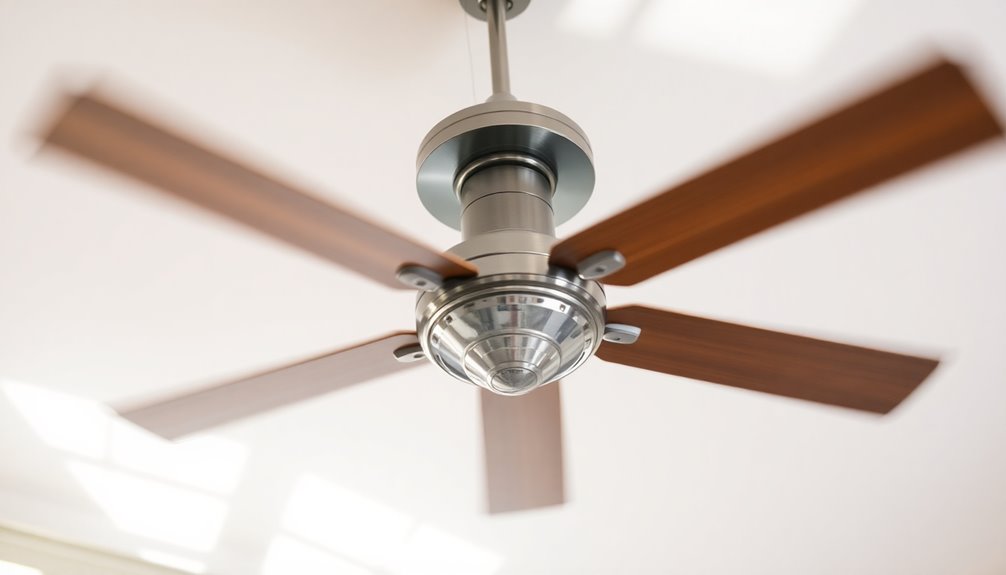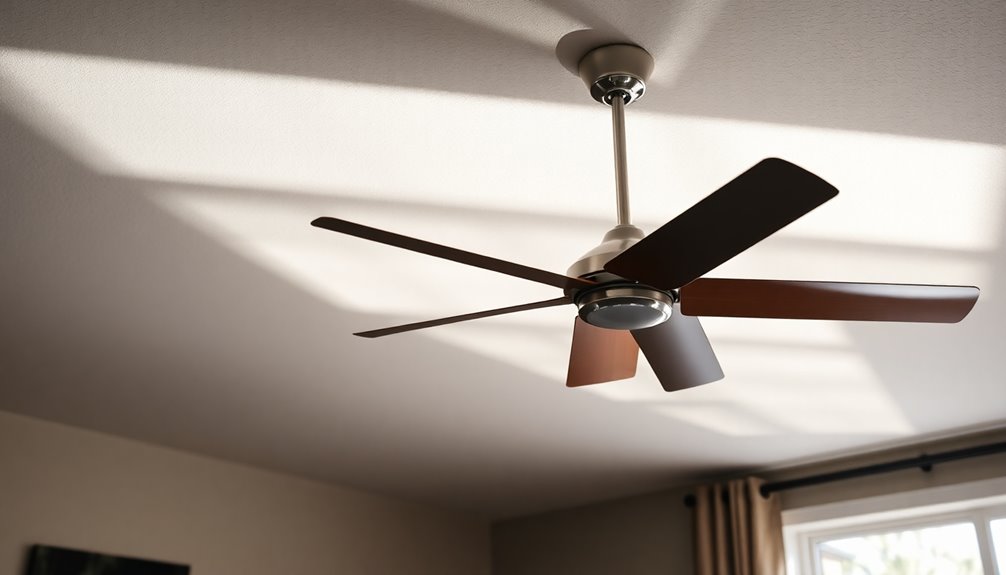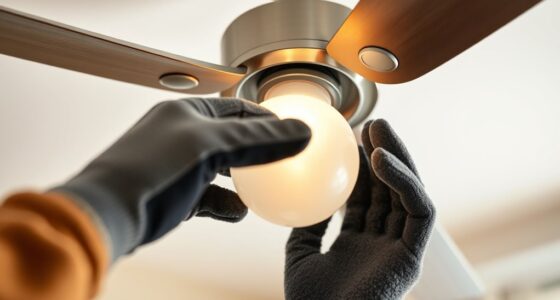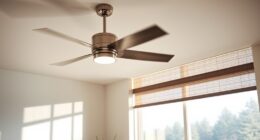Installing a ceiling fan usually costs between $144 and $353. The total depends on factors like existing wiring, which can lower costs to about $100-$300, versus new wiring that might push expenses up to $2,000. If you opt for DIY, you could save some on labor, but a professional guarantees safety and proper installation. Don't forget that additional features, like built-in lights or remote controls, can add $100 to $300 each. Whether you're considering a simple installation or something more complex, you can explore ways to save on costs and make the best choice for your home.
Key Takeaways
- Average ceiling fan installation costs range from $144 to $353, with typical professional installation around $248.
- Existing wiring can lower installation costs to $100-$300, while new wiring may increase expenses up to $2,000.
- Standard ceiling fans typically cost between $50 and $300, while specialty fans can exceed $1,800.
- DIY installations can save $50 to $200 on labor but may compromise safety and compliance with electrical codes.
- Adding features like built-in lights or remote controls can increase installation costs by $100 to $300 each.
Ceiling Fan Installation Costs

When you're considering installing a ceiling fan, it's vital to understand the costs involved. The average cost to install a ceiling fan ranges from $144 to $353, with a typical professional installation costing around $248.
If you have existing wiring, you could lower installation costs to between $100 and $300. However, if you need new wiring, be prepared for expenses that can soar up to $2,000.
Standard ceiling fans typically cost between $50 and $300 for installation, but if you opt for more complex setups, like directional or rotational models, the price can jump to anywhere from $150 to $1,500.
Additional features can also impact the ceiling fan installation costs; built-in lights may add $100 to $300, while remote controls can increase the total by $150 to $300.
If you're handy, DIY installations can save you on labor costs, but it's best to stick with professional installation for complex setups to guarantee safety and compliance with electrical codes. Moreover, investing in energy-efficient appliances can significantly reduce your long-term electricity bills.
Understanding these factors will help you budget accurately for your ceiling fan project.
Factors Influencing Installation Expenses

Several key factors influence the installation expenses of a ceiling fan.
First, labor costs typically range from $50 to $200, heavily affected by your geographic location. Urban areas often see higher prices than rural regions. If you have existing wiring, this can considerably lower your installation costs to between $100 and $300.
However, if new wiring is required, you could face expenses soaring up to $2,000.
The type of ceiling fan you choose also matters. Standard ceiling fan costs fall between $50 and $300, while specialty fans, like hanging propeller or directional models, can exceed $1,800.
Additionally, if your fan has extra features, such as built-in lights or remote controls, be prepared for an increase in overall installation cost by $100 to $300 each.
Lastly, access issues, like high ceilings or tricky installation spots, can inflate both labor and material costs, adding to your installation expenses.
Types of Ceiling Fans

Choosing the right type of ceiling fan can greatly impact both your comfort and the overall aesthetic of your space. When considering a ceiling fan replacement, you'll encounter various types, each with its own installation costs and features. Here's a quick breakdown:
| Type of Ceiling Fan | Installation Cost | Ideal For |
|---|---|---|
| Standard Ceiling Fans | $50 – $300 | Most rooms |
| Low-Profile Ceiling Fans | $50 – $300 | Low ceilings |
| Directional Ceiling Fans | $150 – $800 | Targeted airflow adjustment |
| Hanging Propeller Fans | $150 – $550 | High ceilings |
| Rotational Ceiling Fans | $200 – $1,500 | Complex designs, powerful airflow |
Standard and low-profile ceiling fans are versatile and budget-friendly. Directional and hanging propeller fans cater to specific ceiling heights and airflow needs. Rotational ceiling fans, while more expensive, offer powerful airflow with intricate designs. When you factor in labor costs, hiring a professional electrician may be necessary for more complex installations. Each of these types of ceiling fans can greatly enhance your space, so choose wisely!
DIY vs. Professional Installation

Deciding between DIY installation and hiring a professional can greatly impact both your budget and the quality of your ceiling fan setup.
If you're handy and have a solid understanding of wiring, a DIY installation might save you $50 to $200 on labor costs. However, remember that basic ceiling fan installation can still come with its own expenses.
Here are some key points to contemplate:
- Cost Savings: DIY can cost between $100 to $275, while hiring a professional electrician can range from $60 to $250 per hour.
- Complexity: Simple fan replacements might be manageable for you, but complex setups often require professional help.
- Safety Concerns: Hiring a licensed electrician guarantees safe wiring and compliance with electrical codes.
- Time Investment: DIY projects might take longer due to the learning curve, while professionals typically complete jobs in 1-4 hours.
- Quality Assurance: Professionals guarantee proper handling of wiring issues, giving you peace of mind.
Ultimately, weigh the costs and benefits of DIY versus professional installation to make the best choice for your ceiling fan project.
Tips for Cost Savings

When it comes to saving money on your ceiling fan installation, there are several strategies you can employ.
First, consider installing multiple ceiling fans at once. This can greatly reduce labor costs, as contractors often charge lower hourly rates for larger jobs. Additionally, choose a fan that's compatible with your existing wiring and switches. This simple choice can save you anywhere from $100 to $300 in installation expenses. Moreover, ensuring proper toilet maintenance can prevent the need for frequent plumbing services that might arise from improper installations. Furthermore, integrating energy-efficient technology can lead to additional savings on your overall energy consumption. Investing in regular maintenance can also extend the lifespan of your ceiling fans, reducing long-term replacement costs.
Timing is essential, too. Purchasing ceiling fans during off-peak seasons often leads to discounts and better installation deals.
Don't overlook the long-term savings either; opting for Energy Star-rated ceiling fans can lower your energy bills considerably over time.
If you're replacing an existing fan and the wiring is already in place, hiring a handyperson instead of a professional electrician can help you save an extra $50 to $200.
By combining these tips, you'll not only manage your installation costs effectively but also enjoy ongoing savings on your energy bills. Additionally, understanding your budget will help you make informed decisions on your ceiling fan installation and other home improvement projects.
Frequently Asked Questions
How Much Does Labor Cost to Install a Ceiling Fan?
When you're considering labor costs to install a ceiling fan, it typically ranges from $50 to $200 per hour.
If you've got existing wiring, expect the installation to take about 1-2 hours. More complex jobs may take longer, up to 4 hours.
Hiring a professional usually means spending between $100 and $300 for labor.
If you're adding features like remote controls, be prepared for additional costs, too.
How Much Does Home Depot Charge to Install a Fan?
Think of Home Depot as a craftsman ready to weave comfort into your home.
When you ask how much they charge to install a fan, you'll find their prices typically range from $144 to $353.
Factors like existing wiring and added features can influence the cost.
For simpler installations, you might start at around $100.
If you're considering more complex setups, be prepared for potentially higher expenses.
Can the Average Person Install a Ceiling Fan?
Yes, the average person can install a ceiling fan if you've got basic electrical knowledge and the right tools.
With a screwdriver, drill, and wire stripper, you're set to tackle most installations, which usually take 1-2 hours.
Just make sure to check local building codes to stay compliant.
If your setup gets complicated, don't hesitate to call a licensed electrician for safety and proper installation.
How Long Does It Take a Professional to Install a Ceiling Fan?
Imagine a skilled craftsman, deftly weaving a tapestry of light and air into your home.
When you hire a professional to install a ceiling fan, it typically takes them about 1 to 2 hours if the wiring's already in place.
However, if your project demands new wiring or adjustments, you might find them working on it for 3 to 4 hours.
Their expertise guarantees a smoother, quicker process, transforming your space effectively.
Conclusion
In the end, installing a ceiling fan is like finding the perfect breeze on a hot day—it can transform your space and comfort. By understanding the costs and factors involved, you're better equipped to make an informed choice. Whether you opt for a DIY project or hire a pro, you'll create a revitalizing atmosphere that flows with ease. So, take a moment to weigh your options, and let your ceiling fan become the gentle whisper of coolness in your home.









